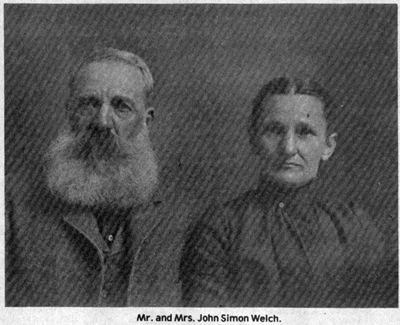August 28, 1980

Picture #1 – Mr. and Mrs. John Simon Welch
Many Confederate and Union soldiers gave their lives on the battlefield or in stinking prison camps when the Civil War divided this nation. However, many survived both perils and returned home to take up their lives and raise families.
In the June 5 Potluck, I told readers about Christian Saalman, and promised to relate the story about the great-grandfather of Mary Reinhard, 236 College Ave., and other descendants of John Simon Welch, one of the Union soldiers who was captured and imprisoned at Andersonville, Ga.
Welch, like Saalman, came from Germany, having been born there in 1840.
He enlisted at age 21, at Fremont, and was mustered in at Camp Chase (near Columbus) on Nov. 7, 1861. He reenlisted at Germantown, Tenn. Dec. 23, 1863.
Captured at Guntown, Mississippi on June 12, 1864, Welch was confined to the dreadful Confederate Prison at Andersonville, Ga. June 25, 1864. He arrived there after Providence Spring burst forth and provided the prisoners with much needed pure water (see Potluck May 4, 1978).
How Welch escaped from Andersonville is information which apparently was not preserved and passed on to his descendents…at least it is not known locally.
He escaped in early April 1865, and he made his way to Union forces at Savannah Ga., joining up with them on April 3.
Shortly after his escape a powerful Union force under General James J. Wilson captured Columbus, Ga. on April 17, 1865 and shortly thereafter all Northern prisoners at Andersonville were freed.
Welch was transferred from Savannah to Camp Chase, May 6, 1865, and later discharged June 22, 185 at Vicksburg, Miss.
He returned to St. Stephens, Ohio and was married to Mary Ann Deer in 1870. Their family of 13 was reared in that small village which is located south of U.S. 224 and east of Ohio 19 about four miles.
Welch and his wife are buried in the parish cemetery at St. Stephens. He died in 1906 and she in 1914. The accompanying photo shows the couple in their late years.
The living descendants in Fostoria are Mary Reinhard, 236 College Ave.; Mrs. Robert Cochie, 722 S. Main; Walter E. Kramb, 10750 Columbus Ave.; Mrs. Mathias Fox, Jr., 214 N. Ave.; William Kramb, 709 N. Union St.; Thomas Kramb, 339 W. Fremont. Other descendents are Robert Kramb, Fremont; E.A. Kramb, Cincinnati; and Sister Mary Louisann, S.N.D., Toledo.
READER FEEDBACK
Florence (Kinnaman) Garner, a native of Fostoria who lived in Columbus many years and now lived in Bryan, Ohio, is one of my readers and an old friend. Recently, she sent me a copy of a poem…”Mother Shipton’s Poem”…reportedly written in 1449, in England.
The poem had been hidden away in the old Kinnaman family Bible for many years. If the poem was written in 1449, many of the predictions enumerated are amazingly accurate although some are not understandable, at least to me.
Who was Mother Shipton? I have no idea. Perhaps some readers may know.
UNION AT SCHOOL
Readers continue to stop me about town to remark about that story since they attended that school. One of them was Bernard Lee, who inquired when the school was demolished. I asked former superintendent H.L. Ford and learned it was 1939. That was the period when Riley, Holmes, Lowell, Bryant and Longfellow schools were built under Ford’s regime as superintendent.
A relic still exists from the old school and I’ll show and tell in another column.
HOW FOSTORIA STREETS GOT THEIR NAMES
In another Potluck column I promised to tell how streets got their names in our city. I may not cover the full list today, but at least part of it.
FOSTER STREET – after whom Fostoria was named
COLLEGE AVENUE – because it led to Fostoria’s college
BANNISTER STREET – named after one of Fostoria’s alderman, corresponding to councilman today. He lived in the house at Tiffin and Wood streets, which was demolished to make way for Ohio Savings & Loan parking lot.
CROCKER STREET – got its name from one of Rome’s pioneer families. The large brick house at 133 E. South St. was the Crocker home.
SOUTH STREET – When Rome was laid out, South St. was its southern boundary.
NORTH STREET – was Rome’s northern boundary in the early days.
MAIN STREET – was the main north and south street of early Rome, and it continued for Fostoria.
CENTER STREET – was (about) the center of early Fostoria and divided it north and south. The street numbering system uses it as the dividing line.
HIGH STREET – that street skirted Fostoria’s High school and was thus named.
POPLAR STREET – so named because of the many poplar trees that once lined that street of many years ago, of which there are few left.
TIFFIN STREET – led to our neighboring town of Tiffin by continuing on Columbus Ave.